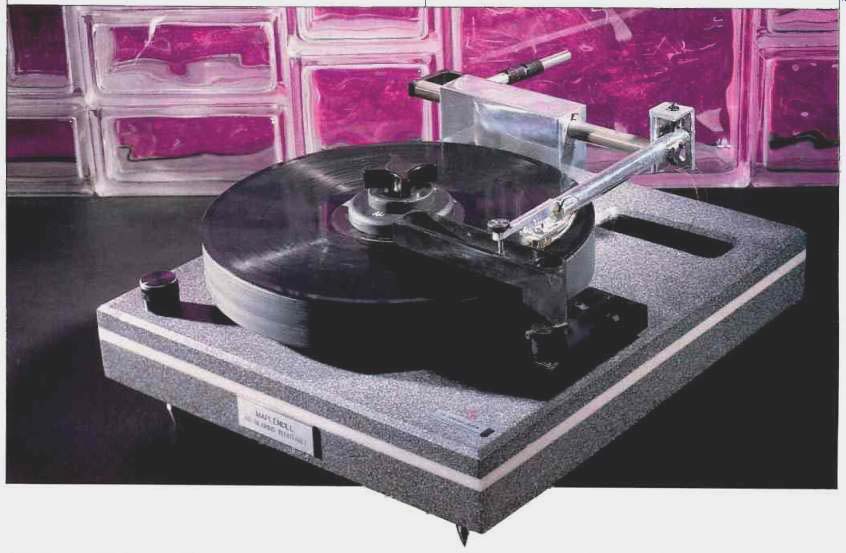
Manufacturer's Specifications:
Turntable Type: Belt drive, with solid lead platter on air bearing.
Speeds: 33 1/3, and 45 rpm.
Speed Accuracy: Within 0.3%.
Wow & Flutter: Less than 0.03%.
Rumble: Less than -80 dB, per DIN 45-529.
Tonearm Type: Linear tracking, with air bearing.
Effective Tonearm Length: 7 in.
Cartridge Weight Range: 3 to 16 grams.
Tracking Force Range: 0 to 6 grams.
Vertical Tracking Angle Adjustment: 1 inch, in 1/200° increments.
Overhang and Anti-Skating: None.
Air Pump Pressure: Nominal, 40 pounds per square inch; maximum, 100 psi.
Dimensions: 14 3/4 in. W x 17 1/4 in. D x 7 in. H (37.5 cm x 43.8 cm x 17.8 cm).
Weight: 135 lbs. (61.4 kg) with 50-lb. lead platter.
Prices: With standard 50-lb. lead platter, $4,095; with 70-lb. platter, $4,275; with 30-lb. platter, $3,915.
Company Address: 1095 Bellbrook Ave., Xenia, Ohio 45385, USA.
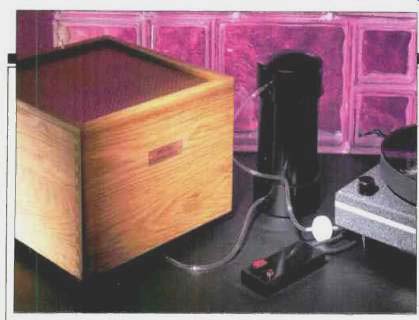
In the past, I have written reports about turntables that had an air-bearing tonearm mounted on them, such as the Eminent Technology and the Goldmund, but Maplenoll's Signature Ariadne goes a step further: It utilizes air-bearing technology for both the main bearing of the turntable and the vertical and lateral bearings of the tonearm. Actually, the Signature tonearm's air bearing combines the vertical and lateral functions into one bearing. If you are not familiar with how air bearings work, you need to know that the bearings are used as the contact area between the load and its support, that is, the air bearing floats the load on a thin film of air. An air compressor is used to supply air that is forced through tiny holes in the fixed part of the bearing; the air spreads out and suspends the moving part of the bearing.
Friction, which is present in other types of bearings, is practically nonexistent in an air bearing, but the fact that a compressor is necessary has limited the use of air bearings for most applications.
Bob Dilger, the president of Maplenoll Electronic Co., related some of the history behind the use of air bearings for turntables and tonearms. He told me that Prof. Lew Eckhard developed the air-bearing turntable platter and tonearm.
The Wayne H. Coloney Co., which had the rights to Eckhard's patents, made an air-bearing turntable in 1978, but by 1980 it was no longer being produced. When Dilger retired from the Air Force, he came across Eckhard's original air-bearing designs. He was intrigued with the idea and bought the rights to the air-bearing turntable and tonearm in 1980. The first turntable and tonearm system Dilger produced, the Athena, was introduced in 1981 and remained in production until 1988; it cost $795. The original tonearm was similar to the Eminent Technology arm. Bruce Thigpen, the president of Eminent Technology, had been with the Wayne Coloney Co. before it got out of the hi-fi business. Dilger says that both the Maplenoll and Eminent Technology air-bearing arms have gone through many design changes and refinements. As a result, although conceptually the same, the two arms have many design differences.
The Shure Ultra 500 moving-magnet cartridge (now discontinued) was selected for this report because it was the top of the Shure line and I felt it would be a worthy companion to the Signature tonearm for the technical measurements and listening tests. I used other cartridges which also per formed well, but the data in this report was generated using the Shure Ultra 500.
The platter of the Maplenoll turntable is the heaviest that I have ever seen or heard of, and it is made of lead. The standard platter is 50 pounds, and lead platters from 30 to 120 pounds are available. The unit I tested had a 70-pound lead platter, although I would recommend you check out one of the lighter platters, which I think would be more than sufficient. Besides its air bearing, the Signature tonearm is also unusual in having a damping system in front of the cartridge position. A bracket, extending out over the cartridge mount, holds a damping plunger that sits in a plastic trough ahead of the cartridge. Damping is provided by a high-viscosity oil in the trough. Motor oil is used because it is soluble in cleaning solutions for vinyl records. If the oil should happen to drop on a record, it will not irreparably harm it. Maplenoll is not the only maker to use this idea; a turntable produced by Townshend Audio in England, the Elite Rock, used a trough for tonearm damping, as does the Well Tempered, which I have reviewed.
The Signature turntable has no suspension and relies on its mass for stability and isolation from outside vibration.
Even with the 70-pound platter removed, it weighed 67 pounds. The heaviness is due mainly to the 40-pound lead stabilizing plate inside the Signature turntable base. The base itself is machined from mottled gray and white DuPont Cohan, then polished to a high gloss.
The Maplenoll turntable base is 14 3/4 inches wide, 17 1/4 inches deep, and 3 3/4 inches high. It is made as a sandwich that is held together by special epoxies and clamped during the long curing process. Polishing the base takes about 5 hours and involves many hand operations. The total height, including the tonearm, is about 81/4 inches. The tonearm counterweight rod extends about 3 3/4 inches beyond the rear of the base, so the actual depth required for the turntable is about 21 inches. A slot, 4 1/2 inches long x 1 3/8 inches wide, extends through the base, near the right rear. This slot allows free passage of the extremely fine tonearm wires from the arm to a plate on the left rear of the base that holds the phono jacks and the ground terminal. The a.c. power cord and the air hose exit from the left rear of the base.
============
MEASURED DATA
Maplenoll Signature Ariadne Turntable
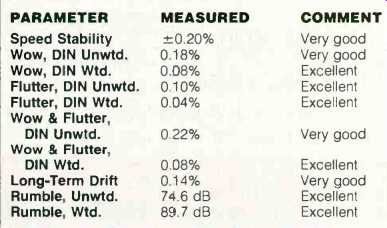
Maplenoll Signature Ariadne Tonearm
Pivot-to-Stylus Distance: 7.375 in. (187 mm).
Pivot-to-Rear-of-Arm Distance: 7.3125 in. (185.7 mm).
Tracking-Force Adjustment: Adjustable counterweight.
Tracking-Force Calibration: None.
Cartridge Weight Range: 5 to 12 grams.
Low-Frequency Resonance: 6.3 Hz with Shure Ultra 500 cartridge.
Counterweights: Three, 12.8 grams each.
Counterweight Mounting: Direct to threaded rod.
Sidethrust Correction: None needed.
Pivot Damping: Special oil-filled trough located in front of cartridge.
Lifting Device: Finger lift.
Headshell Offset: Not needed.
Overhang Adjustment: Slots in headshell.
Bearing Type: Air.
Bearing Alignment: Excellent.
Bearing Friction: Extremely low.
Lead Torque: Very low.
Arm Lead Capacitance: Left, 14 pF; right, 16 pF.
Arm Lead Resistance: 0.8 ohm, each channel.
External Lead Length: None.
Mounting: Integral with turntable.
=============
The motor is mounted directly to the left rear of the base. The dual-diameter pulley on the motor shaft is easily accessible, so the drive belt can be shifted from one diameter to the other to change between the 33 1/3- and 45-rpm speeds.
The Signature turntable's three mounting feet are made from threaded rods and ground to a point. I wouldn't recommend mounting the turntable on anything that you wouldn't mind marking with three indentations, but you can place a quarter under each foot to prevent this. The feet at the right front and center rear are adjusted first, to level the turntable from front to back. This is done by lifting the turntable, turning the bolts, and then locking them into position against the bottom of the base with a hex nut. The left front foot's threaded rod extends through the base and is topped by a knob that allows the final leveling of the turntable to be set very accurately. This adjustment is critical because the air-bearing tonearm will drift to the right or left if it isn't exactly level.
There is a separate switch for the air compressor and the turntable motor; the compressor should be turned on first because it takes a few minutes for a thin film of air to build up between the bearing surfaces. The platter sits on the upper bearing plate and rotates with it. The bearing plates are 8 inches in diameter, and their surfaces are machined to 0.0002 inch. While the bearing could have been smaller, an 8-inch diameter was chosen to improve rigidity and resistance to rocking. The system is preset to provide 50 pounds of air pressure. Since the surface area of the bearing is 50 square inches, the net result is a uniform pressure across the bearing surface of 1 pound per square inch. You can tell if the air bearing is working because the platter turns freely; if the platter doesn't turn at all, then the compressor has not been turned on.
The motor can be turned on next. Because of the high inertial mass of the platter, it takes about 5 or 6 S to come up to speed at 33 1/3 rpm and even longer at 45 rpm; in fact, at the faster speed, a gentle push by hand is useful to give the motor an assist. You might wonder why the platter has to be so massive; the high mass provides a flywheel action to smooth out any variation in speed, and even more important, according to Dilger, record vibrations are damped by the direct contact between the record surface and the mass of the lead platter.
The air compressor is housed in a wooden box made, appropriately enough, from maple. It measures 14 1/4 inches x 13 1/4 inches, is 11 inches high (including its rubber feet), and weighs 40 pounds. The plastic air hose and the power cord, which has an in-line power switch, exit from the bottom of the box. The turntable comes with long hoses that will allow the compressor to be placed far from the listening area. This is important because the compressor, while reasonably quiet, does make a certain amount of noise. My sample also emitted an odor that would not be appreciated in a listening room, but Maplenoll now provides a charcoal filter to prevent this.
As mentioned, the Signature tonearm uses a single air bearing to do the job performed by the vertical and horizontal bearings of a conventional tonearm. A large polished aluminum block serves as the housing for the fixed part of the air bearing; a black polished aluminum rod, 5/8 inch in diameter, passes through a slightly oversized hole in the aluminum block. The inside surface of the block and this surface of the rod are machined to 0.0002 of an inch. The rod, which is free to rotate, provides the vertical bearing action, and it moves laterally as well. A bracket is fastened to the left side of this rod, to which the main tonearm tube is attached; the right side of the rod has a bracket to which the threaded counterweight rod is bolted. The counterweights are three round leaden nuts and a locking plastic hex nut.
The armtube bracket has adjustments for the cartridge azimuth and height above the record surface. The other end of the armtube has a mounting bracket with slots for mounting the cartridge and adjusting its position; as mentioned, the tonearm extends past the cartridge mounting bracket to provide a mounting for the damping plunger. The plunger interacts with the viscous fluid in the trough to provide the damping for the tonearm.
Measurements and Listening Tests
The setup adjustments and technical measurements were made before the listening evaluations so that I could be certain that everything was functioning correctly. The absolute polarity of the reference system and the Maplenoll/Shure system was also checked, and the recorded selections were marked for correct absolute polarity. The members of my listening panel were given a form to rate the reference system and the Maplenoll/Shure system from zero (perfect) to-5 for each musical selection. Panel members are encouraged to write comments about the perceived quality of the sound, but they are asked not to talk or make any outward sign during the playing of a selection. I put the Signature Ariadne's air compressor in a separate location so it would not distract them.
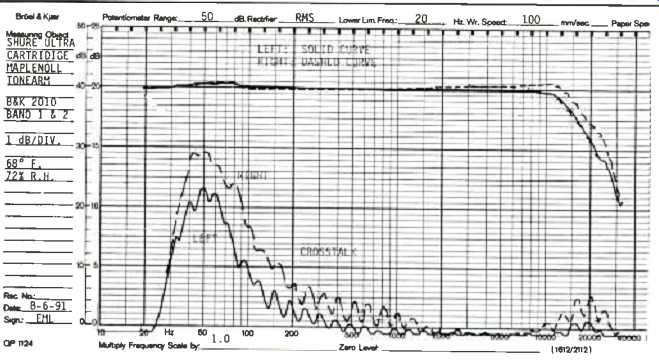
Fig. 1--Frequency response and crosstalk of Shure Ultra 500 cartridge in Maplenoll
Signature Ariadne arm.
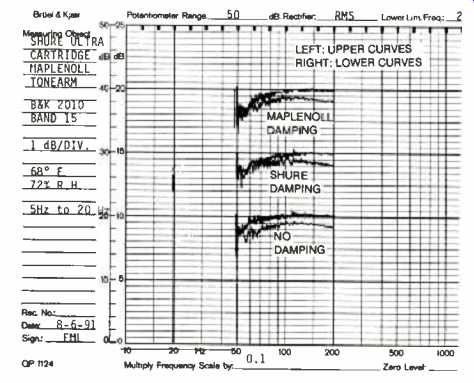
Fig. 2--Low-frequency (5 to 20 Hz) arm cartridge resonance with arm's viscous damping, cartridge's damper, and no damping; see text.
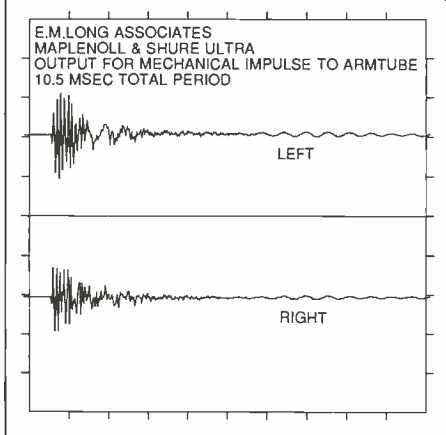
Fig. 3--Output vs. time from an impulse applied to armtube.
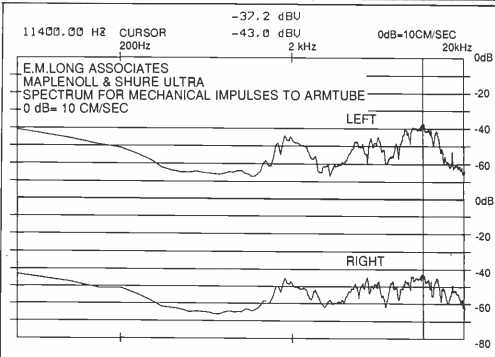
Fig. 4--Spectral output (averaged) from 16 impulses applied to armtube.

Fig. 5--Wow and flutter.

Fig. 6--Speed drift over a 42-S period.
Figure 1 shows the crosstalk and frequency response of the Maplenoll/Shure combination. The output of the left channel is very uniform all the way up to 9 kHz. There is no "sway-backed" depression in the range from 2 to 5 kHz, which has been the case with so many moving-magnet cartridges. The listening panel wrote such comments as "detailed," "articulate," and "sonorous" and gave the Maplenoll/Shure system a "-1" for the sound of voice and strings, very close to perfection. The crosstalk is exception ally low and should remain so across a record because the tonearm tracks linearly across the record and holds the lateral tracking angle constant. The increase in crosstalk in the low-frequency range is an artifact of the B & K 2010 test record.
Figure 2 shows something very interesting. The low-frequency resonance, caused by the interaction of the Signature tonearm's effective mass (including the cartridge's 9.45-gram mass) and the Ultra 500 cartridge's compliance, was tested under three different modes of damping operation: With only the tonearm's damping trough, with only the cartridge's integral damping brush, and with no damping system. The curves are almost identical, which is amazing! It appears that the damping provided by the air bearing is sufficient to control the low-frequency resonance of this tonearm/cartridge combination. I did use the Signature damping system during the listening evaluations. Comments that the sounds of double bass and drums were "deeper," "tighter," and "more realistic" from the Maplenoll/ Shure than from the reference system can be directly correlated to the excellent damping.
I checked for resonances in the range from 20 to 1,000 Hz (not shown) by using the slow sweep on band 6 of the B & K 2011 test record. I found a minor glitch at about 65 Hz that I couldn't correlate with any listener comments. I used the slow sweep on bands 1 and 2 of the CBS CTC-300 test record to check for resonances in the vertical and lateral planes of the system; the curves were virtually identical from 10 to 100 Hz and showed a slight increase in the vertical mode at about 6 Hz.
Figure 3 shows the output for a mechanical impulse applied to the Signature armtube, and Fig. 4 shows the spectrum of the output for a series of 16 such mechanical impulses. The output in the range from 2 to 3 kHz may correlate with a panel member's comment about the sound of brass being "brighter." The Shure Ultra 500 cartridge's phase response was almost perfectly matched between channels-as good as any cartridge I have ever measured and better than most.
Interestingly, this can sometimes produce a negative reaction to the reproduced sound from recordings whose spread of reverberance is less than ideal. Comparing the Maplenoll/Shure system's sound to that of the reference system, some panel members found it "less spacious" and "more confined" on certain orchestral recordings. This seeming problem was due to the reference system's less than perfect interchannel phase response, which added a false spaciousness. The clue to determining this was another comment from the panel that the Maplenoll/Shure system had "less spattering of the sound of cymbals." These comments and the explanation for them might help you when you are trying to decide between any two systems you may want to purchase.
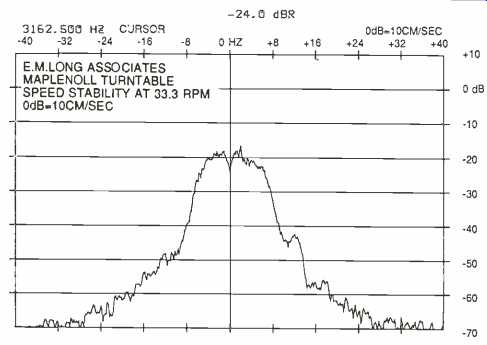
Fig. 7--Speed stability at 33 1/3 rpm, which is excellent.
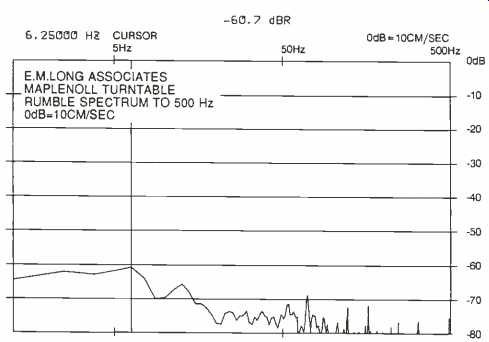
Fig. 8--Rumble spectrum.
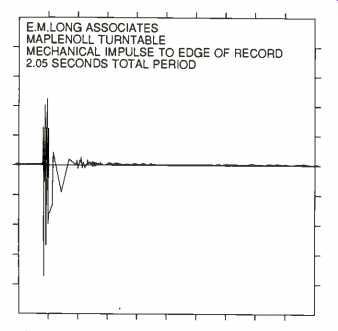
Fig. 9--Output vs. time from a shock applied to the edge of a stationary record.
Figure 5 shows the spectrum of the wow and flutter of the Signature Ariadne turntable. The major output is at 0.5 Hz, which is close to the turntable's 0.56-revolution/S rotational speed; if the resolution of my spectrum analyzer were greater, it would show that the maximum output is, indeed, at 0.56 Hz. The increase in output at the rotational frequency is caused by the fact that the test record is not perfectly centered. Normally, the high 0 of most tonearm/cartridge combinations' low-frequency resonances causes a peak in the wow and flutter spectrum, but the Maplenoll/Shure's output at the 6.3-Hz resonance is very low, which verifies the low Q of its arm/cartridge resonance.
Figure 6 shows the drift in speed of the Signature turntable over a 42-S period. This indicates very good performance and that the Signature provides stable speed, with very little drift over a long period. Figure 7 shows speed stability another way; it is a graph of the variation in the frequency of the 3,162.5-Hz wow and flutter test tone of the B & K 2010 record, averaged over 16 samples. (The test tone is supposed to be 3,150 Hz, but it appears that the turntable which cut the 2010 test record was running about 0.4% slow.) The deviation, ± 6.33 Hz, represents a variation of only ±0.20%, which is excellent. No adverse comments were made by any panel members that would correlate with this slight speed variation.
In Fig. 8, the spectrum of the rumble for the Signature turntable, the rumble is most pronounced at the 6.3-Hz arm/cartridge resonance. However, because the Q is so low at this resonance, the measured rumble is extremely low.
Some panel members commented that the rumble seemed slightly lower from the Maplenoll turntable than from the reference system.
Figure 9 shows the output versus time for a mechanical impulse applied to the edge of a stationary record, with the stylus of the cartridge resting in a groove near the middle of the record. The mechanical energy is well damped and dissipates quickly. The spectrum produced by a series of 16 mechanical impulses, applied to the edge of the record and averaged, is shown in Figure 10. The spectrum above 75 Hz slopes very smoothly downward as the frequency increases, and there are no peaks or dips that would color the perceived sound. Such smooth energy absorption allows each note of a rapid series of musical notes to be distinguished clearly. The listening panel rated the Maplenoll/Shure system very high for this and indicated by their comments that it exceeded the performance of the reference system, which has consistently been rated very high.
The output from the Maplenoll/Shure system, with the stylus resting in a stationary groove near the middle of the record when a mechanical shock was applied to the solid platform on which the turntable rested, is shown in Fig. 11.
The spectrum of this output, for 16 shocks applied and averaged, is shown in Figure 12. There is a decease in energy transfer for most of the range above 100 Hz except for peaks at around 2.8 and 4.0 kHz. Despite the lack of a suspension system, the high mass of the turntable, the stability and low Q of the tonearm/cartridge resonance, and probably the small transmission path of the pointed turntable mounting feet give the Maplenoll/Shure system very good isolation from outside mechanical vibration.

Fig. 10--Averaged spectrum of 16 shocks.
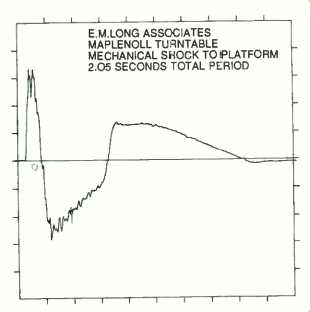
Fig. 11--Output vs. time turntable was resting, for a shock applied to with
stylus in a stationary the platform on which the groove.
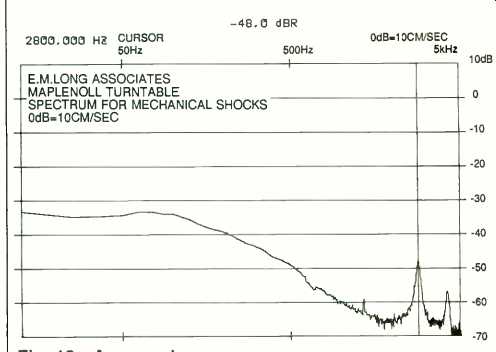
Fig. 12--Averaged spectrum of 16 shocks to platform.
Conclusions
The panel members rated the Maplenoll/Shure system slightly better than the reference system for voice, strings, brass, acoustic guitar, drums, and piano. The systems were rated as being equal when reproducing the sound of a double bass and complex orchestral works. The Maplenoll/ Shure caused the sound of solo violin to be perceived as being "sweeter" and "a little smoother," the sounds of an acoustic guitar were more "precise," and drums were tighter sounding. Ambience was reproduced more faithfully; however, this can sometimes cause a perceived lack of spaciousness that should rightfully be blamed on the recording technique and not on these components. On well-recorded material, there was a real sense of openness and space. Both systems were rated equal in presenting a stereo image that allowed panel members to point at the location of specific instruments. My overall impression of the Maplenoll/Shure was that it provided a very clear and precise sound while being very "polite and subdued" compared to the reference system. If you are considering the purchase of a high-quality record playing system, you should consider the Maplenoll Signature Ariadne turntable and (if you can still find one) the Shure Ultra 500 cartridge.
-Edward M. Long
(adapted from Audio magazine, Jul. 1992)
Also see:
Linn Axis Turntable (May 1987)
MAS Mk. I Turntable/MAS-282 Tonearm (Dec. 1983)
Heybrook TT2 Turntable and Tonearm (Nov. 1984)
= = = =